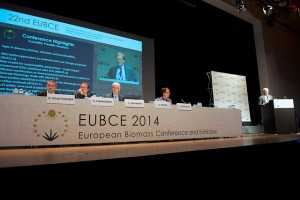
1085 attendees from 66 countries, 674 presentations, 11 parallel and challenge events, and over 100 business to business matchmakings. These are the impressive figures summarizing the 4 days of the 22nd European Biomass Conference and Exhibition, announced last thursday by the technical program manager David Baxter. He recalled how ten years ago at an opening panel of the EUBC&E, one major question addressed to the panelists was “What are the most promising technologies for bioenergy?”and the answer was that there was no technology really ready for commercial exploitation. In the last 10 years technologies have moved a long way, and this year’s edition has clearly demonstrated that this no longer a barrier for large scale bioenergy production. This is the case of large 2nd generation ethanol plants such as those of BioChemtex and Clariant, as well as Valmet’s fast pyrolysis project, or the GTI biogasoline, bio SNG and finally Arkema’s biobased products that were presented to the audience during the four days of the conference.
Technology no longer a barrier. Resource efficiency, system integration and stable policies are challenges ahead for the bioenergy sector
“Now it is the time to focus on how to use biomass in the most efficient and sustainable way, and to develop a stable policy framework to create the conditions for investments to take place in Europe, where technological leadership still resides, instead of letting them go to other countries.” said David Chiaramonti, speaking at the closing panel. Supporting this statement, Clemens Hoffmann, Conference General Chairman expressed his wish that future policies will be ambitious enough to look at the opportunities offered by this green transition, rather than focusing on the costs. “System integration- that is integrating bioenergy in the current energy and renewable energy mix, is also a key element to address today,” said Bernd Krautkremer, Fraunhofer IWES; biomass could provide 100% of balancing power in Germany, and is the key for the development of the whole renewable energy sector.
This view was also shared by Anselm Eisentraut, presenting the mid term scenario for bioenergy developed by the International Energy Agency; “A more integrated energy system is needed to improve efficiency while optimizing energy resources and investments,” he concluded.
Finally the chairman announced that Vienna will be the host city for the 2015 edition of the European Biomass Conference and Exhibition.


